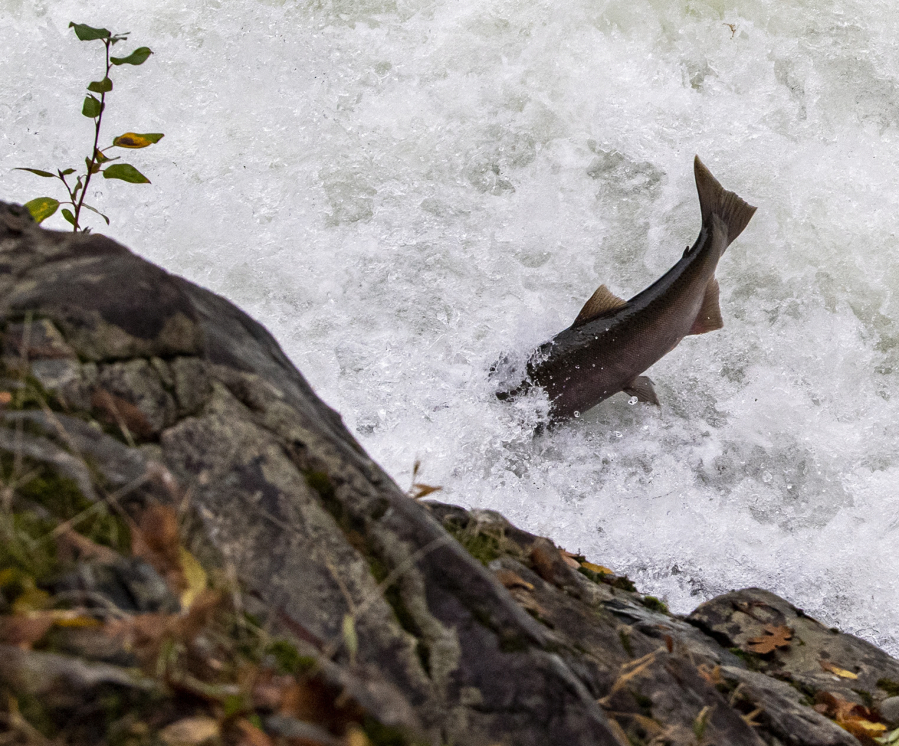Washington is putting more money into a low-tech approach to help salmon thrive. State officials are hoping to plant millions of dollars’ worth of trees along rivers and streams to cool the water and protect the fish.
River and stream water can kill salmon when it hits the mid-70s, according to a joint Washington State University and University of Portland report.
Gov. Jay Inslee and Democratic and Republican lawmakers wanted to tackle warming streams this past legislative session as a way to combat some of the effects of global warming. Inslee’s office and the Ecology and Fish and Wildlife departments met with farming groups, business interests, environmental organizations and several tribes to come up with a system to address the problem.
The main solution identified is simply planting lots of trees along shorelines to provide cooling shade. Also, some straight streams might be made more winding with eddies because slowing the flow also cools the streams that salmon travel to get to and from their spawning grounds. The plan also calls for adding plastic mesh, called riprap, and planting other plants along shorelines to prevent stream erosion.
These ideas are not new — they’ve been employed for at least 30 years in the Pacific Northwest — but the money is.
Tribes, conservation districts, county governments, nonprofit organizations and farmers have tackled hundreds, if not more than a thousand, tiny riparian planting projects all across Washington. For example, roughly 50 tiny riparian restoration projects have been completed in the Methow Valley in the past 20 years.
Inslee wanted to expand and speed this riparian work for habitat protection. While tribal leaders agreed that the work is essential, they offered a range of opinions on the bills under consideration during the legislative session.
“These improvements need to be added to ongoing habitat work,” said Jarred-Michael Erickson, chairman of the business council of the Confederated Tribes of the Colville Indian Reservation, at a Feb. 20 hearing of the House Capital Budget Committee.
David Herrera of the Skokomish Indian Tribe criticized House Bill 1720 because many tribes were not consulted in its development.
“It’s hard to create a perfect bill. … We encourage (the Capital Budget Committee) to provide resources so we can move forward,” said Ron Allen of the Jamestown S’Klallam Tribe.
For fiscal 2023-2024, new tree plantings will be much less extensive than Inslee and legislators dreamed about four months ago. They were thinking of adding $100 million to the state budget for this work, but settled on $50 million, to be split between two projects in the $9.2 billion capital budget for 2023-2025. Individual landowners can request part of the $25 million allocated to the Washington Conservation Commission or from an additional pool of $25 million set aside from the state’s cap-and-trade auction income. None of these riparian improvements are mandatory.
“You make incremental progress with what (legislation) you can get through. … There will be more work to be done,” Inslee said of accomplishing less than he’d wanted in the 2023 session.
Originally, Rep. Mike Chapman, D-Port Angeles and chairman of the House Agriculture & Natural Resources Committee, introduced two similar bills — House Bills 1215 and 1720 — to create two grant programs to provide money for rivershore and creekside tree plantings and other riparian improvements. Both bills failed to advance through the Legislature, so the heavy lifting happened during budget negotiations.
HB 1215 would have set up a grant program under the conservation commission; adopt landowner riparian standards for grant recipients; set up a salmon riparian habitat policy task force; and set up an interagency coordinating committee. Also, the state would have coordinated with tribes on riparian projects.
Meanwhile, HB 1720 would have created two riparian grant programs — one administered by the conservation commission and one by the Washington Salmon Recovery Funding Board. It also would have established a Salmon Riparian Habitat Policy Task Force that needed to submit an annual report to the Legislature beginning in 2025.
Both bills failed in part because they did not involve all the right people and agencies in the decision-making, including the state’s Fish and Wildlife and Ecology departments and Indigenous nations. Chapman said business and agricultural interests preferred HB 1720, which had the governor’s office and state agencies participating solely in an advisory capacity on the task force, not as formal voting members.
Ruth Musgrave, a senior policy adviser to Inslee, said the two state departments have spearheaded riparian improvements and should have roles with legitimate clout in allocating the money. The Stillaguamish, Skokomish and Suquamish tribes voiced similar concerns at a Feb. 7 Agriculture Committee hearing.
Ultimately the bills were replaced by the two $25 million allocations in the budget without any administrative additions.
Rep. Steve Tharinger, D-Port Townsend and chairman of the House Capital Budget Committee, said the administrative issues will be tackled in a future session. “It’s sort of an evolving program,” he said.



